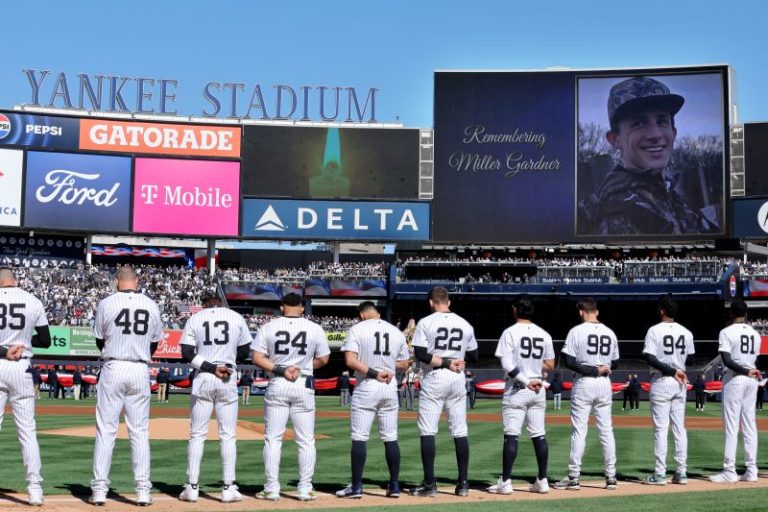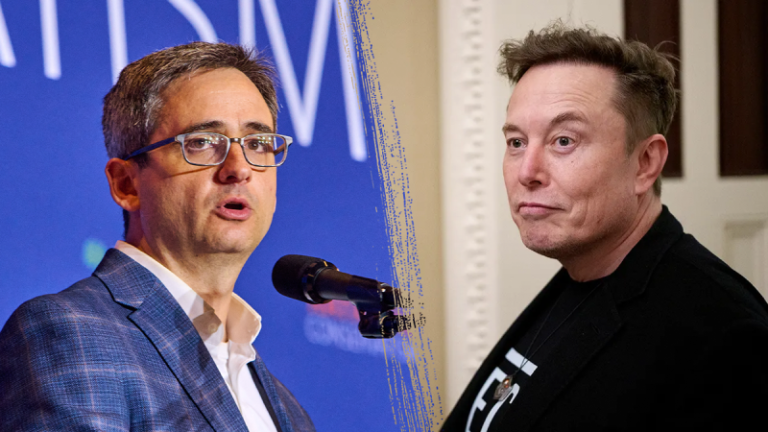WEST SACRAMENTO, Calif. — They stood in line for hours before the gates opened Monday, snapped pictures and tried to fully comprehend the enormity of the moment.
For the first time, an authentic regular-season Major League Baseball game was being played in Sacramento, California.
They may not be called the Oakland Athletics any longer, but they are still the Athletics, playing in front of a sellout crowd of 12,192 against the Chicago Cubs at Sutter Health Park, proud to call West Sacramento their new home.
It wasn’t a game the Athletics will show on their season highlight reel, routed, 18-3, with Cubs catcher Carson Kelly hitting for the cycle, but it was still a new beginning.
“We’ve been embraced here,’’ A’s manager Mark Kotsay says, “in every which way.’’
They had all of the pomp and circumstance just like every other home opener in their history, but nothing was quite like this night. The entire Athletics team wore No. 24 in honor of the late Hall of Fame outfielder Rickey Henderson. Henderson’s three daughters threw out the ceremonial first pitches. Dave Stewart, the legendary A’s pitcher who was one of Henderson’s best friends, was on hand, too.
It was an emotional evening for Stewart, born and raised in Oakland. He hated leaving the Coliseum, but seeing the euphoria, all of the joy, fans stopping and taking pictures of him as he tried to get to his suite, let him understand what it meant for the people of Sacramento.
“You know, it’s not the best of feeling that this isn’t happening in Oakland,’’ Stewart said, “but the other piece of this is that I’m part of the organization, whether I work for them or not. My number’s retired here. I’m in their Hall of Fame. It’s a good period right now for the A’s.’’
The crowd thoroughly appeared to enjoy themselves from the opening introductions where the Athletics came through the center field wall, the video tributes for Henderson, the moment of silence, the flyover and the glorious moment they furiously waved their gold towels when shortstop Jacob Wilson hit the A’s first home run in the third inning.
“People are excited, the community seems excited, to have us here,’’ A’s outfielder Brent Rooker says, “and the city has been very welcoming to us as individuals and as a group as a whole.’’
The lingering hostility in Oakland, at least for this night, vanished into the cool 50-degree air. It wasn’t until the end of the sixth inning, with the A’s getting blown out, when there were a few scattered, “Sell the Team’’ chants as they headed towards the exits.
Before the game, fans exuberantly chanted, “Let’s Go Oakland,’’ as if they were still back in the Coliseum. A’s owner John Fisher, who rarely attended games after he announced they were leaving Oakland for Las Vegas in three years, was even warmly cheered for bringing the A’s to Sacramento in the interim.
“I can’t believe we’re here, this is a once-in-a-lifetime opportunity,’’ said Melanie Huitt, sitting in row 22, seat 13 and 14 with her husband, Dennis. “This is a dream come true, for all of us who are from here. Now we get to see every single major-league team here.’’
Sure, there were a few glitches. Athletics reliever Osvaldo Bido walked through the back gate at Sutter Heath Park, tried to open the clubhouse door, and only saw Chicago Cubs players. He retreated, stepped outside, and not understanding English, finally was escorted to his own clubhouse.
There were 150 credentialed media members for the inaugural game, prompting A’s officials to use a makeshift tent for interviews before the game, but the howling wind and rattling of metal made it a bit uncomfortable. One reporter was nearly hit by a fly ball during batting practice while leaving the clubhouse.
A’s veteran pitcher Luis Severino, who signed the richest contract in A’s history with a three-year, $67 million deal, says the A’s delivered on all of their promises, but is already worrying how he was going to navigate going from the dugout to the clubhouse while walking through the center field gate during a game. It may be commonplace in the minor leagues, but it’s the only stadium in the major leagues with the inconvenience.
“So, if you have a bad game,’’ said Severino, who’s scheduled to start Tuesday, “some fans can let you know right away. That’s our reality, so we have to embrace it.’’
Candlestick Park in San Francisco, which hosted its last baseball game on Sept. 30, 1999, was the last major-league ballpark not to have their dugout attached to the clubhouse. Yet, there’s not a single active player who had the experience of playing at Candlestick, as Cubs manager Craig Counsell subtly discovered.
“I was telling the players the last park that I remember where the clubhouses weren’t attached to the dugout was Candlestick,” Counsell said, “and they just kind of looked at me with a blank stare… It’s just different. We all get afraid of different, but we’ve all done this before so it’s no big deal. …
“You just do it. We’re playing major-league baseball game every night, so you just embrace it, and do it.’’
Counsell drew the same kind of blank stares when he tried to convince reporters that he saw an actual River Cat the nickname of Sacramento’s Triple-A team, while walking to the ballpark, even though it was actually a water otter.
The Athletics were pleasantly surprised to see just how modern and luxurious their new clubhouse was at the San Francisco Giants’ Triple-A park, roomy enough for a ping-pong table in the middle with a new weight room, gym and dining area.
The Cubs now know what it’s like for visiting teams at Wrigley, but despite being the smallest visiting clubhouse in baseball, there were minimal complaints.
“I got a big-league locker, I’ve got all of the tools that I need, and it’s a privilege to put on a major league uniform,’’ Cubs veteran shortstop Dansby Swanson said. “We’re just very, very fortunate to play this game, no matter when or where, no matter what the stadium is, no matter where it may be located, it doesn’t matter.
“This is a major-league baseball game that should never be taken for granted.’’
There wasn’t a single Cubs player who publicly voiced his discontent at playing a major-league game in a minor-league stadium, and if anyone was upset, they were keeping their opinions private.
“My opinion doesn’t really matter, it’s where we’re at,’’ Cubs veteran infielder Justin Turner said. “It’s obviously unfortunate for all of the great fans in Oakland. I feel for them, but it’s a great opportunity for people up here in Sacramento to get a chance to have a major-league team for a couple of years.
“As far as whether it’s a good thing or a bad thing, I guess we’ll find out.’’
Despite all of the euphoria at Sutter Health Park, it still was emotional for the players who called Oakland home, particularly for Cubs second baseman Nico Hoerner, who was born and raised in Oakland.
“I’d rather be playing in Oakland,’’ Hoerner said. “Oakland is special place for me. …It’s really sad. It’s a very storied franchise and a place that is integral to a lot of people’s experience of being in the East Bay, and families that had generations of fans and a lot of passion. …
“I feel for fans in Oakland, baseball fans, sports fans in general. All three teams [A’s, Raiders and Warriors] being gone in a very short span is hard-hit to an entire community. Three teams have created a lot of joy for a lot of people.
“I think sports plays a great role and place, and to have all of that stripped away very quickly is a really challenging thing.’’
Then, again for players like A’s reliever Tyler Ferguson, who grew up in Sacramento and has lived in the city for the past five years, there’s nothing like being at home again. He was the most popular man in spring training advising his teammates where to live, telling them about the best restaurants, coffee spots and nightlife. He plans to do a pamphlet with the team chaplain, who lives in the Sacramento area.
“To be playing in Sacramento, basically at home and in the big leagues,’’ Ferguson said, “is a really cool experience for me. The fans are very excited. A couple of times I was back this offseason, people that aren’t huge baseball fans are buying season ticket and are excited to have major league baseball in Sac.’’
Still, for those A’s longtime employees who have been uprooted, and abandoning their loyal legion of small, but passionate fan group, Ferguson certainly understands their pain. He hopes the A’s fans still stick with them, whether they’re in Sacramento now or Las Vegas later.
“I understand the frustration that fans have had over the past few years,’’ Ferguson said, “but we hope that they rally behind this team here in Sacramento while we’re here. We’re still the Athletics. Hopefully, people will be excited to come support us and we win a lot of baseball games.’’
The A’s believe the sellout crowds, the fans’ enthusiasm, the community’s support, could play a role in their path to the postseason before they depart for Las Vegas. They went from 50 victories to 69 in the last year, and believe they can be a potential contender this season.
Who knows, the better the A’s play, the more fans they attract, and the more people that come to Sacramento, the A’s could be a walking billboard for the chamber of commerce?
“This is a big-league city,’’ A’s veteran reliever T.J. McFarland says. “There’s a lot going on here. So, I think everyone’s going to be, I shouldn’t’ say surprised, because it’s a nice city, the state capital, but it’s going to be a really nice fit.’’
Best of all, the A’s say, is that all of the questions about the A’s uncertainty, their move from Oakland, their future in Sacramento, should now finally end. Finally, they can talk about, well, baseball again.
“I hope questions from you guys turn into more of baseball-related questions,’’ McFarland said, “as exposed to the external factors that we have no say in. I’d love to answer normal ones again.
“Hopefully, this passes, everyone gets normalized, and it’s like all right, “Let’s pop open the hood and figure out who’s actually on this team and actually how good they actually are.
“If we do what we think we can do, and win games, we’re going to prove all of the people wrong that are saying things won’t be different. For us, we have a little chip on our shoulder.’’
So, the A’s aren’t about to let one game, one clunker on their glorious opening night, ruin an entire summer.
“My hope, my vision, is that it feels like a very big SEC college baseball game in terms of the energy that we bring with the capacity that’s allowed,’’ said Rooker, who attended Mississippi State. “It’s going to be a unique environment, and it offers an opportunity to bring major league baseball to a city that hasn’t previously had it, to help us continue to further develop and build our fan base.
“I think we’re fully ready to embrace it.’’
Follow Nightengale on X: @Bnightengale
This post appeared first on USA TODAY










